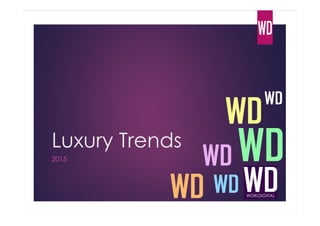
Luxury trends 2015
- 2. The Luxury Consumer The Omnivore – 25% - Typically new to luxury, younger, experimental, usually women with a preference for aspirational brands, usually purchased in brand’s own stores The Opinionated – 20% - Highly educated Generation X and Y shoppers who distinguish between brands The Investor – 13% - Interested in quality and durability, to pass from generation to generation, discretionary spending The Hedonist – 12% - Focused on the luxury shopping experience, affinity for branded accessories The Conservative – 16% - Mature, mainstream shoppers The Disillusioned – 9% - Long-time, infrequent buyers of luxury, predominantly women shopping online The Wannabe – 5% - Global middle class 25% 20% 13% 12% 16% 9% 5% Source: Adapted from Bain & Company, ‘Lens on the Worldwide Luxury Consumer,’ 2014
- 3. India – a natural emerging luxury market The luxury market in India accounts for 10% of total retail and is expected to be worth $15 billion in 2015. Luxury retail in India is distinguished by a twin focus on short-term luxury products, notably jewellery, and long-term investment in luxury assets, particularly cars. This segment shows the highest growth rate – driven by a wider choice of brands and rapid increase in millionaires in tier one and two cities – leading to a value of US$8 billion in 2015. Trends shaping luxury retail in India are local market strategies, digitalisation, sustainability, consolidation versus niche opportunities and products made in other emerging economies.
- 4. “Luxury is based on emotion and it is people who create emotional differences. Competing on product provides less advantage – but using people as a competitive differentiator creates the emotional benefits that drive loyalty, protect brand value and build brand equity”.
- 5. Too many brands In 2015, look for many more large, medium and start- up brands to stall, or fail, at a faster rate than over the last few years. Affluent consumers, chased to exhaustion, are swamped by too many me-too options in every category. It will be time for true luxury brands to stop benchmarking the mundane players, understand their own brand identity, values, and standards, and get back to delivering differentiated, fully-priced value in 2015.
- 6. Comparable Store And E-commerce Sales Are The Critical Metrics Look for luxury brands in 2015 to stop opening stores completely, even close some, and focus surgically on pinpointing true opportunities to open profitable new stores. The three mantras of luxury economics in 2015 will be: driving new valuable clients to online and offline channels, dramatic increases in conversion, and profitable retention of all high potential clients, not just the VIPs.
- 7. Brands Are Finally Getting Serious About Human Relationships In the coming year, look for more brands to finally begin building deeper relationships with large percentages of online and multi-channel customers. Although resources are scarce, brands should build intimate relationships with, at a minimum, their top 20% to 40% of clients. In 2015 we are extremely optimistic that the economic conditions will force brands to get moving on building better client relationships rooted in personal interaction rather than impersonal algorithms. Personal shopping assistants will be in demand.
- 8. Think Less Facebook, More Pinterest Social media can certainly serve a useful purpose. Sites and apps like Pinterest and Instagram that engage visually have a far better chance of success for the eye-candy offerings of many luxury brands. Look for localized and personalized efforts to thrive within these highly engaging media and look for the leading edge brands to empower all front-line associates to post their favorites in a brand-sanctioned way. In this way, a brand can engage clients and prospects in rich, honest dialogue that builds relationships and boosts sales.
- 9. Content - Brand safe experiences Luxury brands are increasingly wary of traditional media advertising where their content was placed on sites that promised premium exposure, but too often saw their content distributed across sites with poor ad visibility or outright click-fraud. As brands have started to invest in long-form video content, they have begun either hosting it on their own site or placing it on the sites of premium publishers.
- 10. Content - Multiscreen story- telling Most content is nowadays designed for consumption online. However, users are spending more time on mobile devices. Branded content viewed across multiple screens increases awareness and engagement. Brands will start to create content optimized for mobile usage – for example, shorter-form, mobile Web-based – and create story arcs that are designed to engage across online, mobile and connected television devices.
- 11. We help our clients develop their brands and create compelling engagement models across digital media platforms.
